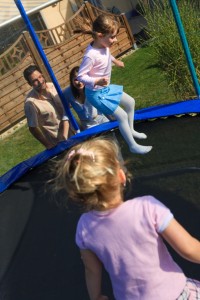Trampolines and Holiday Homes
Last Updated on September 8, 2022 by admin
 Trampolines and holiday homes, a fun combination or an accident waiting to happen? A fact many people won’t be aware of is that the lightest person on a trampoline is five times more likely to be injured. This happens through a phenomenon called “kipping”. This is where jumping at the same time causes the transfer of kinetic energy to the lightest person causing them to gain greater propulsive force and height. There’s an easy answer to prevent this, have a one at a time rule for your trampoline.
Trampolines and holiday homes, a fun combination or an accident waiting to happen? A fact many people won’t be aware of is that the lightest person on a trampoline is five times more likely to be injured. This happens through a phenomenon called “kipping”. This is where jumping at the same time causes the transfer of kinetic energy to the lightest person causing them to gain greater propulsive force and height. There’s an easy answer to prevent this, have a one at a time rule for your trampoline.
Whilst bumps and bruises are commonplace with the use of trampolines more serious fractures, neck and head injuries are not uncommon either. There are more than 10,000 trampoline related injures each year in the UK.
Many trampolines will be springing up across holiday home gardens in the next month or two. It’s vitally important for holiday home owners to effectively manage the risks. Whilst also allowing their visitors to enjoy the fun a trampoline can bring.
Providing your guests with clear guidance
Communicating with your guests on the safety surrounding your property and trampoline should be a vital element. Proactively managing the potential risks to your visitors demonstrates good practice.
Here are just a few points to be considering if you have a trampoline in your holiday home garden:
One at a time
- On average 2.7 children are on a trampoline when an accident happens. Allowing only one child at a time greatly reduces the potential for injuries.
The right trampoline for the right age
- Larger trampolines aren’t suitable for younger children and toddlers. Always make sure you’ve consulted with the manufacturers guidance on the recommended age of use and ensure you’re visitors are aware.
Always supervise
- Whilst supervision doesn’t guarantee injury free play on a trampoline an adult should always be present and may be able to pick up on potential incidents before they occur.
Sensible dismount
- One hospital has reported a third of the injuries they see are as a result of bouncing off the trampoline when dismounting. Remember that although your trampoline should be placed on a soft surface such as wood chip or grass these can still be relatively unforgiving if dropping from a considerable height.
Somersaults
- It can sometimes be tempting to push the boundaries and try new moves on a trampoline. There have been incidents of serious neck and head injuries coming from children attempting somersaults on trampolines. It’s important to also let your visitors know that these moves shouldn’t be performed.
Stand back
- It it’s a child’s turn next on the trampoline make sure they’re kept a safe distance back from the trampoline whilst others are bouncing.
A trampoline can be a great asset for your holiday home. Being aware of the potential risks and having a proactive communication plan for your guests is important. This will increase the chances of injury free fun during those long summer evenings.
ROSPA Trampoline Guidance
For more information and guidance on trampoline safety please visit:
For further information and a quotation for your holiday home insurance call our specialist team on 01237 429444.
This article on trampolines and holiday homes has been created as generic guidance. It does not constitute legal or insurance advice. Do you have any questions relating to health and safety management and the provision of a trampoline for use by holiday letting guests? Discuss them with your broker or insurer and read the ROSPA guidance.









Leave a Reply
Want to join the discussion?Feel free to contribute!